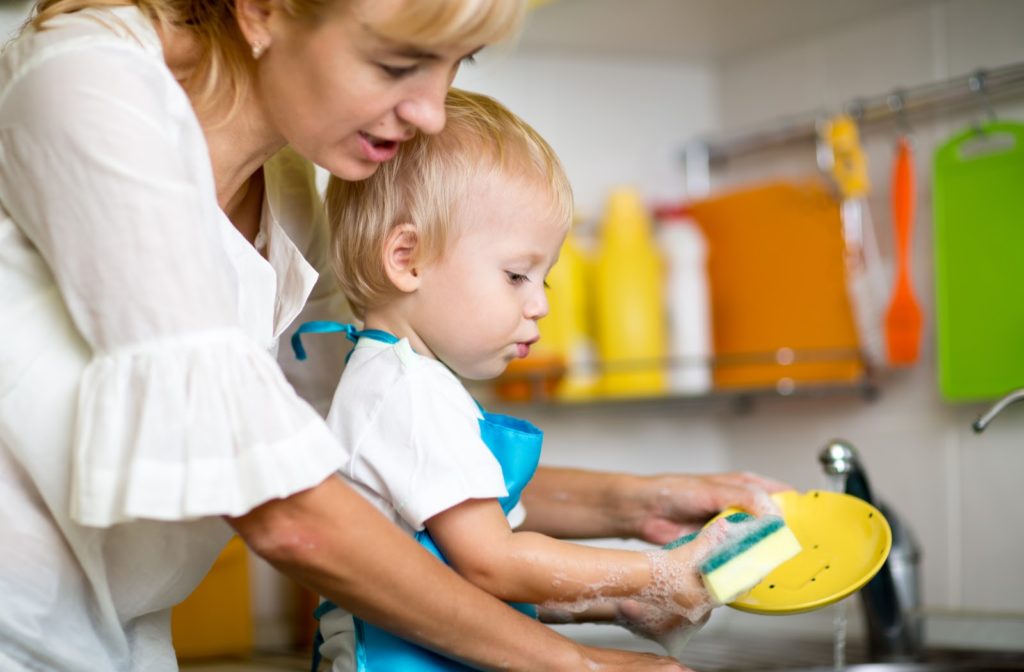Make Montessori a Way of Life
The Montessori method can have many benefits in the classroom, but did you know that you can apply many aspects of the Montessori method at home? By embracing the same principles in your home, you can create an environment that fosters continued learning and development. There are many great resources available to learn more about the Montessori method and how you can implement it, but here are a few tips on where to start.
General Attitudes Towards Learning
The Montessori method focuses on building children’s ability to make their own decisions. There are a number of ways you can encourage this at home by creating an environment that fosters independence and trying new things.
Encourage Self-Motivation
Children are more willing to try things if they are intrinsically motivated. Some studies have even shown that children who are promised a reward actually do worse than children who are just given the task. It might be tempting to reward your children with gold stars or sweet treats, but pride and pleasure in their work have a much more meaningful effect on children.
Children who learn to be intrinsically motivated learn to work hard even when there is no reward, a skill that will be crucial throughout your child’s life. Even verbal praise is given sparingly in Montessori classrooms.
If you do reward your children, do it sparingly through verbal praise. When you do praise your children, make sure you are praising their effort and not the outcome. Praising your child’s hard work teaches them that their attitude towards work is more important than outcomes like beautiful crafts or good grades.
Watch from a Distance
The Montessori method doesn’t advocate leaving your children unsupervised, but it does emphasize independent learning. At home, that means watching your child from a distance while they play. Let them play without interrupting and see what they can accomplish.
See what your child can accomplish when they are left to play and figure things out on their own. Are they able to create games for themselves? Can they put toys back in their place? See how your child does and then reflect on what you could do to help them improve.
Watching from a distance also gives you an opportunity to observe what naturally captures your child’s interest. Based on your child’s interests, you can then create opportunities for your child to pursue what naturally captures their attention. Don’t be afraid to let your child try new things or adapt as needed.
Demonstrate, Engage, Do
Children will want to mimic you naturally, so modelling an activity first is a great way for children to learn. After you have demonstrated the task, invite your child to participate with you under your guidance. Once they’ve tried the task under your supervision, allow them to try the task on their own.
Teaching children like this is a great way to introduce new tasks. Household chores are a good place to start. Not only does this promote learning, but it builds children into capable adults.
Exercises & Routines to Encourage Learning
Organization
The way you organize your home can have a big impact on your child’s learning. Also known as the prepared environment in the Montessori world, purposefully arranging your child’s room and play areas can allow for more learning opportunities.
Everything, especially your child’s things, needs a designated place. When everything has a designated place it’s much easier for children to learn where to find things and how to put things away on their own. For child-specific items like toys, clothes, and snacks, these designated places need to be accessible to your child.
Make organization child-friendly by putting toys on shelves they can see on clothes on racks they can reach. Organization helps when it’s time to clean up and can help build other skills like choosing outfits (because your child can actually reach and see all of their options). You can even take it a step further in the kitchen and place healthy snacks and water within your child’s reach so they can learn to help themselves.

Toy Rotation
Simplify your home so your child doesn’t have limitless options for toys and other items. Instead of a bucket overflowing with toys, place a select few at your child’s eye level and rotate through toys periodically. Once a month is about how often you want to change out your child’s toys.
Limiting your child’s options helps to prevent boredom and maintains curiosity. It might seem daunting at first, but it’s a great way to encourage your child to try new things. One of the best ways to do this is based on what your child is naturally interested in. Did a recent trip to the zoo spark an interest in animals? Then this is a great time to re-introduce toys and books with an animal theme.
Responsibility
It’s never too young to start teaching children responsibility and life skills. Teaching your child to take care of themselves and others allows them to become independent, capable, and caring. You will likely have to give lots of reminders at first, but children will eventually learn to do things like clean up their space at the dinner table all on their own.
When teaching responsibility for household chores, match the task with your child’s age (although you might be surprised by what your youngest children can accomplish when given the chance!). Preschoolers can start with cleaning up toys, wiping surfaces, and putting clothes away. As your child gets older, you can add more complex tasks like cooking, taking out the garbage, and coaching younger children.
Socialization
One aspect that really separates the Montessori method from traditional schooling is the multi-aged classrooms. In order to prepare your child for this style of learning and increase the benefits, let your child play with children younger and older than them.
By encouraging socialization with children of different ages, your child will learn how to cooperate with all children. Embracing this aspect of Montessori schooling at home can make your child more inclusive, cooperative, and kind.


